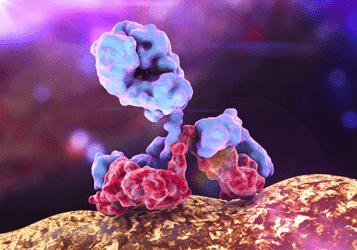- Home
- Products
- Customized ADCs
- ACVR2B
- Anti-ACVR2B (Bimagrumab)-MC-Vc-PAB-SN38 ADC
Anti-ACVR2B (Bimagrumab)-MC-Vc-PAB-SN38 ADC (CAT#: ADC-W-654)
This ADC product is comprised of an anti-ACVR2B monoclonal antibody conjugated via a MC-Vc-PAB linker to SN38. The SN-38 is targeted to certain cancers by immunerecognition and delivered into cancer cells via receptor mediated endocytosis. Within the cell, SN-38 binds to DNA, causes DNA damage.
- ADC Target
- ADC Antibody
- ADC Linker
- ADC payload drug
- Name
- ACVR2B
- Alternative Names
- ACVR2B; activin A receptor, type IIB; activin receptor type-2B; ActR IIB; HTX4; ACTRIIB; ActR-IIB;
- Target Entrez Gene ID
- 93
- Target UniProt ID
- Q13705
- Overview
- Activins are dimeric growth and differentiation factors which belong to the transforming growth factor-beta (TGF-beta) superfamily of structurally related signaling proteins. Activins signal through a heteromeric complex of receptor serine kinases which include at least two type I (I and IB) and two type II (II and IIB) receptors. These receptors are all transmembrane proteins, composed of a ligand-binding extracellular domain with cysteine-rich region, a transmembrane domain, and a cytoplasmic domain with predicted serine/threonine specificity. Type I receptors are essential for signaling; and type II receptors are required for binding ligands and for expression of type I receptors. Type I and II receptors form a stable complex after ligand binding, resulting in phosphorylation of type I receptors by type II receptors. Type II receptors are considered to be constitutively active kinases. This gene encodes activin A type IIB receptor, which displays a 3- to 4-fold higher affinity for the ligand than activin A type II receptor.
- Overview
- Human Anti-ACVR2B IgG1-lambda antibody, Bimagrumab
- Generic name
- Bimagrumab
- Host animal
- Human
- Species Reactivity
- Human
- Name
- MC-Vc-PAB (maleimidocaproyl-valine-citrulline-p-aminobenzoyloxycarbonyl)
- Description
- Peptide linkers, belonging to Enzymatically cleavable linkers, combine greater systemic stability with rapid enzymatic release of the drug in the target cell. The scission of peptidic bonds relies on lysosomal proteolytic enzymes, which have very low activities in blood due to endogenous inhibitors and the unfavorably high pH value of blood.
- Name
- SN-38 (7-ethyl-10-hydroxycamptothecin)
- Description
- SN38 (7-ethyl-10-hydroxy camptothecin) is an active metabolite of the cancer prodrug, irinotecan, with the ability of inhibiting Topoisomerase I, which is belong to the camptothecin family. SN-38 is formed via hydrolysis of irinotecan by carboxylesterases and metabolized via glucuronidation by UGT1A1.
For Research Use Only. NOT FOR CLINICAL USE.
Related Products
- Anti-CD5 (Zolimomab aritox)-SPDB-DM4 ADC (CAT#: ADC-W-927)
- Anti-CD79b-BMPEO-DM1 ADC-1 (CAT#: ADC-W-025)
- Anti-MET (Onartuzumab)-MC-MMAF ADC (CAT#: ADC-W-1540)
- Anti-TNFRSF8 (Brentuximab)-DBCO-MMAF ADC-5 (CAT#: ADC-W-252)
- Anti-CD40LG (Toralizumab)-SPDB-DM4 ADC (CAT#: ADC-W-921)
- Anti-IL1B-MC-Vc-PAB-DMEA-(PEG2)-duocarmycin SA ADC-1 (CAT#: ADC-W-1339)
- Anti-TNFRSF8-β-glucuronide-doxorubicin propyloxazoline ADC-12 (CAT#: ADC-W-353)
- Anti-B-cell lymphomas (Detumomab)-SMCC-DM1 ADC (CAT#: ADC-W-2180)
- Anti-NCA-90 (Lemalesomab)-MC-MMAF ADC (CAT#: ADC-W-2164)
- Anti-CD19 (Taplitumomab paptox)-MC-Vc-PAB-SN38 ADC (CAT#: ADC-W-774)
Published Data
+ Submit Publications

Scientific Resources
Customer Reviews and FAQs
There are currently no Customer reviews or questions for ADC-W-654. Click the button above to contact us or submit your feedback about this product.
Quick Links
Other Products
Same Target
Same Linker
Same Payload
| CAT# | Product Name | Linker | Payload |
| ADC-W-651 | Anti-ACVR2B (Bimagrumab)-SPDB-DM4 ADC | SPDB (N-succinimidyl-4-(2-pyridyldithio)butyrate) | DM4 (N2'-Deacetyl-N2'-(4-mercapto-4-methyl-1-oxopentyl)maytansine) |
| ADC-W-652 | Anti-ACVR2B (Bimagrumab)-MC-MMAF ADC | MC (maleimidocaproyl) | MMAF |
| ADC-W-653 | Anti-ACVR2B (Bimagrumab)-MC-Vc-PAB-MMAE ADC | MC-Vc-PAB (maleimidocaproyl-valine-citrulline-p-aminobenzoyloxycarbonyl) | MMAE |
| ADC-W-650 | Anti-ACVR2B (Bimagrumab)-SMCC-DM1 ADC | SMCC (N-succinimidyl 4-(Nmaleimidomethyl)cyclohexane-1-carboxylate) | DM1 (N2'-Deacetyl-N2'-(3-mercapto-1-oxopropyl)maytansine) |
| ADC-W-655 | Anti-ACVR2B (Bimagrumab)-MC-Vc-PAB-DMEA-(PEG2)-duocarmycin SA ADC | MC-Vc-PAB-DMEA-(PEG2) | duocarmycin SA |
| CAT# | Product Name | Linker | Payload |
| ADC-W-2587 | Anti-EGFR (Zalutumumab)-MC-Vc-PAB-SN38 ADC | MC-Vc-PAB (maleimidocaproyl-valine-citrulline-p-aminobenzoyloxycarbonyl) | SN-38 (7-ethyl-10-hydroxycamptothecin) |
| ADC-W-2623 | Anti-NCAM1 (Lorvotuzumab )-MC-Vc-PAB-MMAE ADC | MC-Vc-PAB (maleimidocaproyl-valine-citrulline-p-aminobenzoyloxycarbonyl) | MMAE |
| ADC-W-2607 | Anti-ITGB3 (Tadocizumab)-MC-Vc-PAB-MMAE ADC | MC-Vc-PAB (maleimidocaproyl-valine-citrulline-p-aminobenzoyloxycarbonyl) | MMAE |
| ADC-W-2614 | Anti-MS4A1 (Rituximab)-MC-Vc-PAB-SN38 ADC | MC-Vc-PAB (maleimidocaproyl-valine-citrulline-p-aminobenzoyloxycarbonyl) | SN-38 (7-ethyl-10-hydroxycamptothecin) |
| ADC-W-2602 | Anti-GPNMB (Glembatumumab)-MC-Vc-PAB-SN38 ADC | MC-Vc-PAB (maleimidocaproyl-valine-citrulline-p-aminobenzoyloxycarbonyl) | SN-38 (7-ethyl-10-hydroxycamptothecin) |
| CAT# | Product Name | Linker | Payload |
| ADC-W-2608 | Anti-ITGB3 (Tadocizumab)-MC-Vc-PAB-SN38 ADC | MC-Vc-PAB (maleimidocaproyl-valine-citrulline-p-aminobenzoyloxycarbonyl) | SN-38 (7-ethyl-10-hydroxycamptothecin) |
| ADC-W-2569 | Anti-MUC16 (Sofituzumab)-MC-Vc-PAB-SN38 ADC | MC-Vc-PAB (maleimidocaproyl-valine-citrulline-p-aminobenzoyloxycarbonyl) | SN-38 (7-ethyl-10-hydroxycamptothecin) |
| ADC-W-2581 | Anti-CEACAM5-MC-Vc-PAB-SN38 ADC | MC-Vc-PAB (maleimidocaproyl-valine-citrulline-p-aminobenzoyloxycarbonyl) | SN-38 (7-ethyl-10-hydroxycamptothecin) |
| ADC-W-2624 | Anti-NCAM1 (Lorvotuzumab )-MC-Vc-PAB-SN38 ADC | MC-Vc-PAB (maleimidocaproyl-valine-citrulline-p-aminobenzoyloxycarbonyl) | SN-38 (7-ethyl-10-hydroxycamptothecin) |
| ADC-W-2558 | Anti-CD79B (Polatuzumab )-MC-Vc-PAB-SN38 ADC | MC-Vc-PAB (maleimidocaproyl-valine-citrulline-p-aminobenzoyloxycarbonyl) | SN-38 (7-ethyl-10-hydroxycamptothecin) |
Online Inquiry
Welcome! For price inquiries, please feel free to contact us through the form on the left side. We will get back to you as soon as possible.



